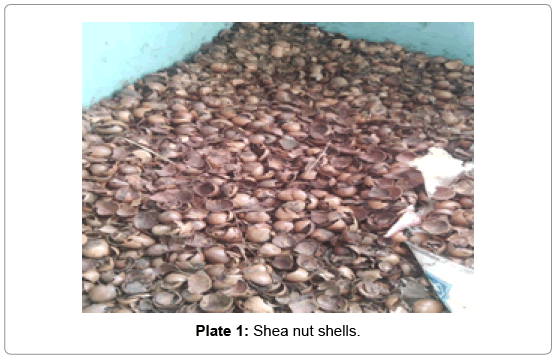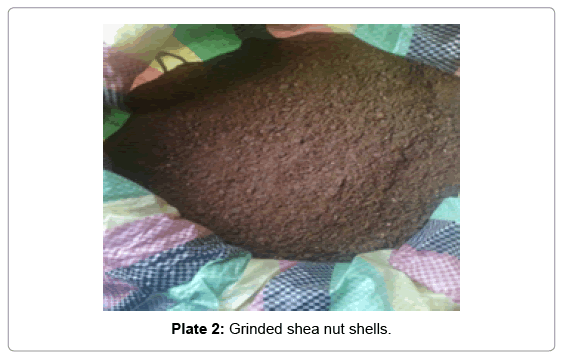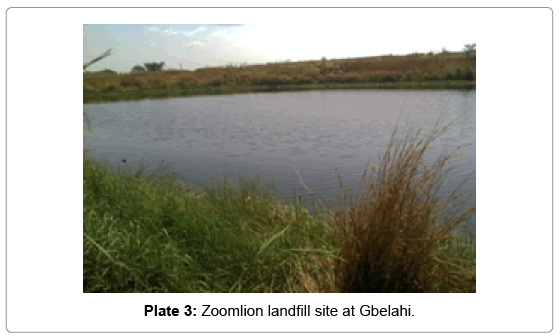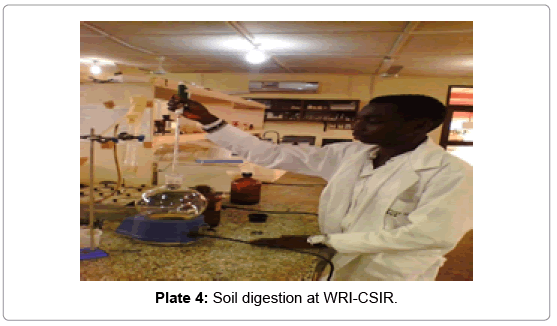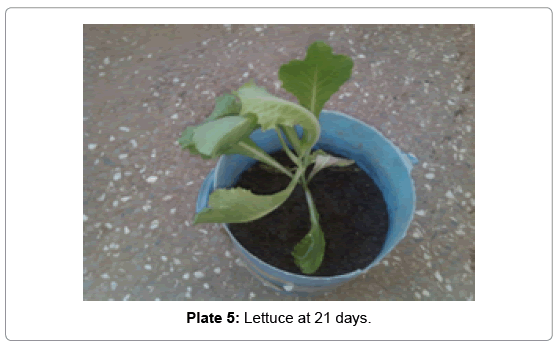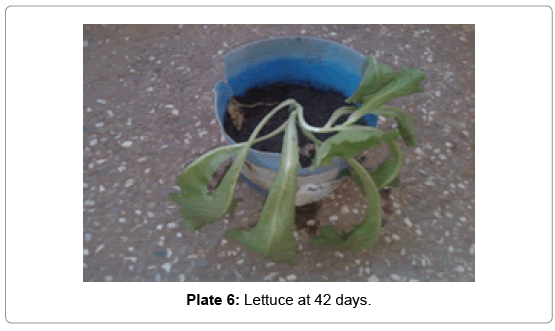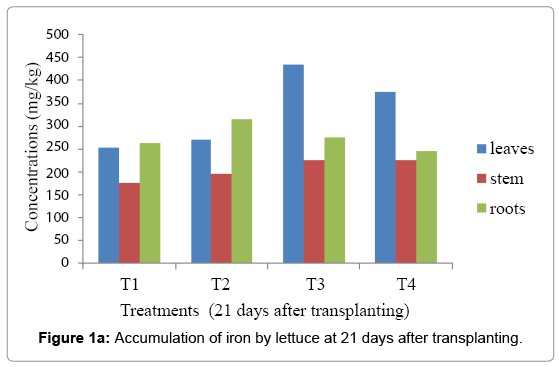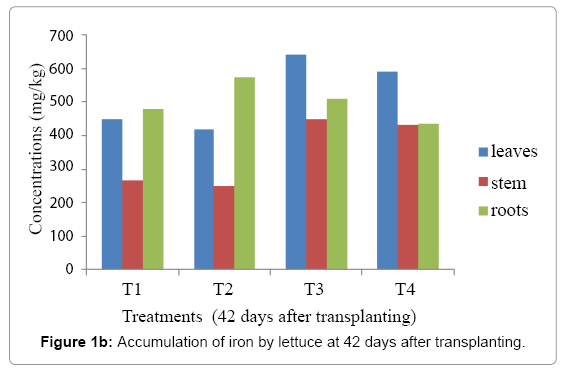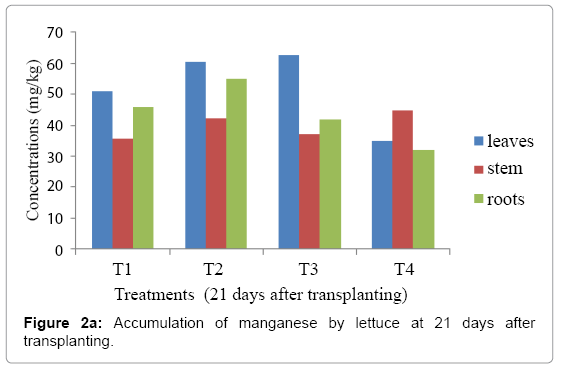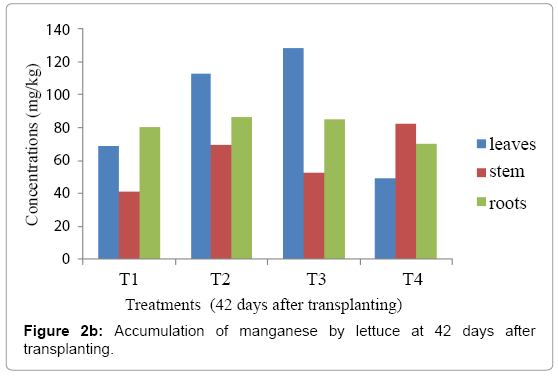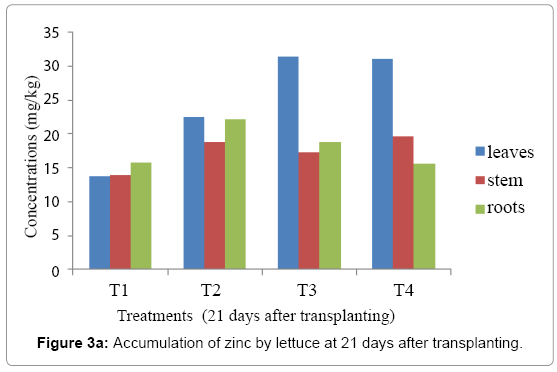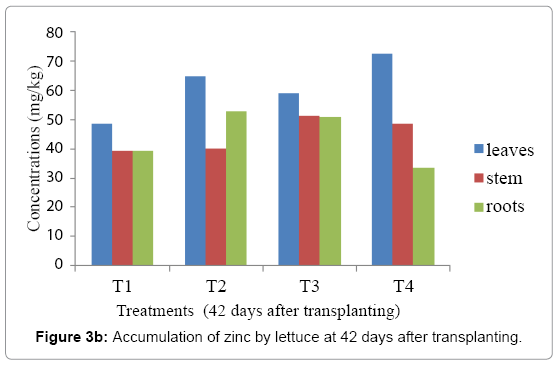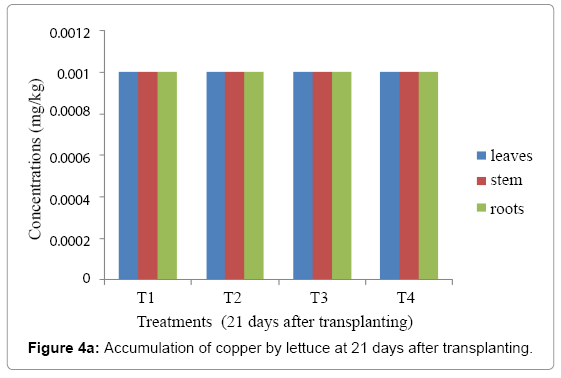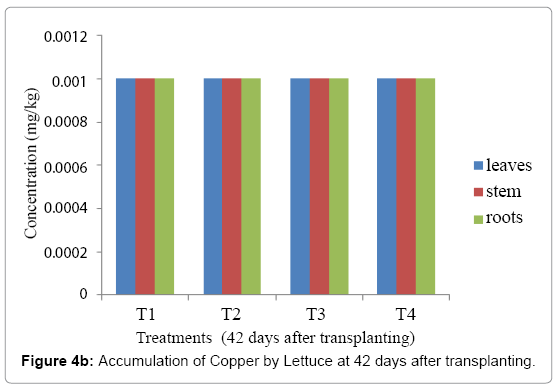Research Article Open Access
The Potential of Shea Nut Shells in Phytoremediation of Heavy Metals inContaminated Soil Using Lettuce (Lactuca sativa) as a Test Crop
Quainoo AK1*, Konadu A1 and Kumi M2
1Department of Biotechnology, Faculty of Agriculture, University for Development Studies, Tamale, Ghana
2Water Research Institute, Tamale, Ghana
- *Corresponding Author:
- Quainoo AK
Department of Biotechnology, Faculty of Agriculture
University for Development Studies, Tamale, Ghana
Tel:+233 37 202 2078
E-mail: aquainoo@googlemail.com
Received Date: August 25, 2014; Accepted Date: December 25, 2014; Published Date: December 31, 2014
Citation: Quainoo AK, Konadu A, Kumi M (2015) The Potential of Shea Nut Shells in Phytoremediation of Heavy Metals in Contaminated Soil Using Lettuce (Lactuca sativa) as a Test Crop. J Bioremed Biodeg 5:268. doi: 10.4172/2155-6199.1000268
Copyright: © 2015 Quainoo AK, et al. This is an open-a ccess article distributed under the terms of the Creative Commons Attribution License, which permits unrestricted use, distribution, and reproduction in any medium, provided the original author and source are credited.
Visit for more related articles at Journal of Bioremediation & Biodegradation
Abstract
Contamination of soil and water by heavy metals cause serious risks to living organisms especially humans and the ecosystem in general through direct contact, inhalation and dermal contact. In this study, shea nut shells were used as adsorbent for heavy metals from contaminated soil. Shea tree (Vitellaria paradoxa) is one of the economic tree crops prevalent in Northern Ghana. Leafy vegetables depend on water for their growth and survival and have massive potential of accumulating heavy metals in their edible parts. Accumulation of heavy metals in leafy vegetables makes them dangerous to human health when consumed. It is within this perspective, which made it imperative for the application of shea nut shells to remove heavy metals such as manganese, iron, zinc and copper from contaminated soil with lettuce (Lactuca sativa) as a test crop. Plastic pots filled with soil from Nyankpala with drainage holes at the bottom and contaminated water from Zoomlion landfill site at Gbelahi in Northern Region of Ghana was used. Atomic Absorption Spectrophotometer was used to determine manganese, iron, zinc and copper in the test crop (lettuce). The mean concentration of heavy metals after 21 and 42 days of transplanting were; Fe (271.135 mg/kg and 457.791 mg/kg), Mn (45.245 mg/kg and 77.211 mg/kg) and Zn (20.049 mg/kg and 50.108 mg/ kg). The concentration of copper was below the level of 0.001 mg/kg. According to the results obtained from this research, shea nut shells have the potentials of adsorption of heavy metals from contaminated soil and water hence it is recommended as suitable means of phytoremediation.
Keywords
Soil; Heavy metals; Waste water; Vegetables; Shea nut shells
Introduction
Soil pollution has currently been attracting substantial public attention since the magnitude of the problem in our soils call for instantaneous action [1]. Anthropogenic activities such as mining and smelting of metalliferous ores, gas exhaust, fuel production, fertilizer and pesticide application, and metal pollution, has become an important problem today. The unchangeable nature of metals has made them a group of pollutants of much concern [2]. Some of the heavy metals associated with soil pollution include copper, manganese, iron and zinc.
Copper is a reddish metal that is found naturally in rock, soil, water, sediment, and at low levels in air. Copper normally enters human body through drinking water or with food, soil or other substances that is known to have copper. Deliberately high intakes of copper can cause liver and kidney hurt and even death [3]. Manganese is a naturally occurring element and an important nutrient. Manganese toxicity can end up in a lasting neurological disorder known as manganism accompanied with signs such as tremors, complexity walking, and facial muscle spasms [4]. Iron is the second most copiously metal in the earth’s crust, of which it accounts for about 5%. The normal lethal dose of iron is 200-250 mg/kg of body weight, but death has occurred after the ingestion of doses as low as 40 mg/kg of the body weight [5]. Zinc is one of the utmost frequent elements in the Earth's crust. It is present in the air, soil, water and is found in most food Ingesting high levels of zinc for several months may cause anemia, damage the pancreas, and decrease levels of high-density lipoprotein (HDL) cholesterol [6].
The implications derived from eating foods containing these heavy metals are very horrific and deadly and therefore necessitates characterization and remediation of the soil bionetworks. This research is undertaken to determine the ability of shea nut shells in bioremediation thus, removing heavy metals from contaminated water and polluted soil and also to evaluate concentrations of heavy metals that will be accumulating in the various parts of the test crop. It is expected that this research will determine the ability of shea nut shells as a suitable choice in bioremediation.
Materials and Methods
Experimental materials and site
The experiment was carried out at the Plant House of the University for Development Studies, Nyankpala Campus, Ghana. Plastic pots were used in carried out the experiment with drainage holes, created at the bottom of the pots for free drainage of excess water in order to prevent water logging. The media was in a ratio of two parts of sandy loam mixed with one part of grinded shea nut shells of which lettuce (Lactuca sativa) was used as the test crop for the experiment. The wastewater that was used in the experiment was collected from Zoomlion Landfill Site at Gbelahi near Tamale in the Northern Region of Ghana. Equipments used in digestion of the soil and the test crop included the Shimadzu Atomic Absorption Spectrophotometer model AA 6300, Satorious electronic weighing scale model TE612, Clamp, Pipette, Round bottom flask, Heat mantle and Crison pH meter Basic 20.
Experimental procedure
Both the soil and water samples were initially digested using 2.5 ml of HNO3 and 2.5 ml of H2SO4. The metals were then analyzed using Shimadzu Atomic Absorption Spectrophotometer model AA 6300. The soil was digested using 0.5 g of the soil sample. The pH of the soil and wastewater samples was 6.55 and 5.64 respectively.
Experimental set up
The set up comprised of four treatments each replicated three times. The containers were arranged on the platforms using the Completely Randomized Design. The treatments were as follows; T1=Shea nut shells+Unpolluted water+Soil, T2=Shea nut shells+Polluted water+Soil, T3=Unpolluted water+Soil, T4=Polluted water+Soil. The seeds of the test crop were nursed for three weeks and later transplanted into the plastic pots containing soil and grinded shea nut shells. At 21 days after transplanting, the first parts of the sample were analyzed and the second part 42 days after transplanting.
Analysis for Mn, Fe, Zn and Cu
Analysis of Mn, Fe, Zn and Cu was based on standard method of analysis of heavy metals adopted by the WHO/FAO. Heavy metals determinations in the samples were carried out in the laboratory of Water Research Institute of Council for Scientific and Industrial Research (WRI-CSIR), Tamale. Mean levels of each of the treatments were analyzed to determine accumulation levels using Microsoft Excel 2010.
Plates
Some pictures showed the materials used for the experiment, experimental activities and the test crop (lettuce) used for the experiment. These are arranged in Plates 1-6.
Results
Samples of the test crop were analyzed according to the leaf, stem and root at 21 and 42 days after transplanting. The Tables 1-4 indicated the mean and standard deviation levels of the heavy metals at 21 and 42 days after transplanting.
| Heavy metals | 21 Days | 42 Days | ||
|---|---|---|---|---|
| Mean (mg/kg) | Standard deviation | Mean (mg/kg) | Standard deviation | |
| Fe | 230.929 | 48.100 | 398.101 | 116.518 |
| Mn | 44.091 | 7.778 | 63.457 | 20.165 |
| Zn | 14.485 | 1.154 | 42.397 | 5.529 |
| Cu | 0.001 | 0.000 | 0.001 | 0.000 |
Table 1: Mean level of heavy metals in treatment one at 21 and 42 days after transplanting.
| Heavy metals | 21 Days | 42 Days | ||
|---|---|---|---|---|
| Mean (mg/kg) | Standard deviation | Mean (mg/kg) | Standard deviation | |
| Fe | 260.441 | 60.155 | 413.913 | 163.162 |
| Mn | 52.509 | 9.415 | 89.532 | 21.749 |
| Zn | 21.112 | 2.059 | 52.585 | 12.326 |
| Cu | 0.001 | 0.000 | 0.001 | 0.000 |
Table 2: Mean levels of heavy metals in treatment two at 21 and 42 days after transplanting.
| Heavy metals | 21 Days | 42 Days | ||
|---|---|---|---|---|
| Mean (mg/kg) | Standard deviation | Mean (mg/kg) | Standard deviation | |
| Fe | 311.683 | 109.238 | 533.026 | 98.065 |
| Mn | 47.192 | 9.706 | 88.725 | 38.137 |
| Zn | 22.501 | 5.482 | 53.827 | 4.603 |
| Cu | 0.001 | 0.000 | 0.001 | 0.000 |
Table 3: Mean levels of heavy metals in treatment three at 21 and 42 days after transplanting.
| Heavy metals | 21 Days | 42 Days | ||
|---|---|---|---|---|
| Mean (mg/kg) | Standard deviation | Mean (mg/kg) | Standard deviation | |
| Fe | 281.487 | 81.089 | 486.123 | 90.528 |
| Mn | 37.188 | 6.753 | 67.129 | 16.899 |
| Zn | 22.099 | 5.703 | 51.623 | 19.755 |
| Cu | 0.001 | 0.000 | 0.001 | 0.000 |
Table 4: Mean levels of heavy metals in treatment four at 21 and 42 days after transplanting.
Comparison of heavy metals accumulated by lettuce
The comparison of mean level of Fe, Mn, Zn and Cu accumulated in the test crop (Lettuce) at 21 and 42 days after transplanting are presented in Table 1.
From Tables 1-4, it was observed that, there were an increased accumulated mean in Fe, Mn, Zn and Cu levels by Lettuce after analysis at 42 days of transplanting as compared with the analysis at 21 days after transplanting in all the treatments.
The Table 5 shows the initial concentrations of Mn, Fe, Zn and Cu in the soil and water samples used in for the experiment and WHO/ FAO standards for maximum permissible levels of heavy metals in vegetables.
| Heavy metals | Concentrations (mg/kg) | |||
|---|---|---|---|---|
| Polluted water | Unpolluted water | Soil | WHO/FAO standards | |
| Fe | 113.898 | <0.001 | 10007.000 | 425.50a |
| Mn | 4.200 | <0.001 | 35.060 | 500.00a |
| Zn | <0.001 | <0.001 | 0.580 | 99.40a |
| Cu | 1.500 | <0.001 | 8.748 | 73.30a |
aAnonymous (2001).
Table 5: Initial concentrations of heavy metals in the soil and water samples and WHO/FAO standard.
Iron accumulation by lettuce
Iron recorded different levels of accumulation at 21 days after digestion of the test crop (lettuce), ranging from 175.686 mg/kg to 434.412 mg/kg (Figure 1a).
According to Figure 1a above, treatment one accumulated highest level of iron of 263.530 mg/kg in roots, followed by leaves with accumulated value of 253.570 mg/kg and stem with accumulated value of 175.686 mg/kg. In treatment two, the same trend happened with roots accumulated highest value of 315.001 mg/kg, followed by leaves with accumulated value of 270.392 mg/kg and stem with least accumulated value of 195.932 mg/kg. In treatment three, the leaves accumulated the highest value of 434.412 mg/kg, followed by roots with accumulated value of 275.540 mg/kg and stem with least accumulated value of 225.098 mg/kg. In treatment four, leaves accumulated highest value of 275.540 mg/kg, followed by roots with accumulated value of 245.344 mg/kg and stem with least accumulated value of 224.754 mg/ kg.
Different accumulations were recorded in all the treatments as shown in Figure 1b above. In treatment one, the roots accumulated highest iron of 480.830 mg/kg, followed by the leaves with 448.624 mg/kg and the stem recorded least accumulated value of 264.848 mg/ kg. This can be demonstrated as roots>leaves>stem. In treatment two, the same trend of highest root accumulation followed by leaf and stem occurred as it happened in treatment one but in treatment three and four, different accumulations were recorded. In treatment two, roots accumulated 574.668 mg/kg of iron, followed by leaves with accumulated value of 418.624 mg/kg and stem with least accumulated iron of 248.446 mg/kg. In treatment three, leaves accumulated more irons, followed by the roots and the stem with the same accumulations recorded in treatment four. Accumulated values in treatment three were as follows; leaves (640.470 mg/kg), roots (510.266 mg/kg) and stem (448.342). Accumulated values in treatment four were follows;leaves (590.648 mg/kg), roots (435.062 mg/kg) and stem (432.664 mg/ kg).
Manganese accumulation by lettuce
Manganese recorded varied levels of accumulation in all the treatments of the test crop (lettuce). The accumulation rate ranges from 31.886 mg/kg to 68.798 mg/kg (Figure 2a). In Manganese, the highest value of accumulation of 62.798 mg/kg was recorded in treatment three with the highest mean of accumulation of 52.509 mg/kg was recorded in treatment two (Figure 2a).
Manganese recorded different levels of accumulation in all the treatments of the test crop (Lettuce). In treatment one, manganese accumulated more in the leaves (50.944 mg/kg), followed by the roots (45.692 mg/kg) and the stem (35.638 mg/kg) with the same trend in treatment two and three. Accumulation levels in treatment two were as follows; leaves (60.396 mg/kg), roots (55.040 mg/kg) and stem (42.090 mg/kg). Accumulation levels in treatment three were as follows; leaves (62.798 mg/kg) roots (41.790 mg/kg) and stem (36.988 mg/kg). However, different accumulation values were recorded in treatment four. In treatment four, it was observed that, the manganese accumulated more in stem (44.798 mg/kg) followed by leaves (34.888 mg/kg) and roots (31.886 mg/kg).
Different accumulations of manganese were recorded in the leaves, stem and roots in all the treatments as shown in Figure 1b. Treatment one accumulated more manganese in the roots (80.224 mg/kg) followed by leaves (69.066 mg/kg) and stem (41.082 mg/kg) at 42 days after transplanting. In treatment two, manganese accumulated more in the leaves (112.668 mg/kg) followed by the roots(86.424 mg/kg) and stem (69.504 mg/kg).These same accumulations were recorded in treatment three, with leaves (128.62 8 mg/kg), roots (84.904 mg/kg) and stem (52.642). However, it was observed that, in treatment four, the stem recorded high manganese accumulation of 82.242 mg/kg, followed by roots (70.252 mg/kg) and leaves (48.886) as shown in Figure 2b above. It was observed that, highest accumulation value of 128.628 mg/ kg was recorded in treatment three with least value of 41.082 mk/kg recorded in treatment one (Figure 2b). On the average, treatment two accumulated more manganese than the rest of the treatments.
Zinc accumulation by lettuce
Zinc, recorded different levels of accumulation rate in all the treatments. The highest mean of 22.500 mg/kg was recorded in treatment three with the least mean of 14.485 mg/kg recorded in treatment one.
Diverse accumulation levels of zinc were recorded at 21 days after transplanting (Figure 3a). Treatment one accumulated high level of zinc in roots (15.810 mg/kg) followed by stem (13.946) and leaves (13.698). In treatment two, leaves accumulated highest level of zinc of 22.476 mg/kg, followed by roots (22.118) and stem (18.744) with the same trend occurred at treatment three. In treatment three, leaves accumulated 31.414 mg/kg of zinc, followed by roots (18.772 mg/kg) and stem (17.318 mg/kg). Moreover, treatment four high accumulated more zinc in leaves (31.112 mg/kg), followed by stem (19.622 mg/kg) and roots (15.564 mg/kg).
At 42 days after transplanting, treatment one accumulated high amount of zinc in leaves (48.782 mg/kg), followed by the roots (39.244 mg/kg) and stem (39.166 mg/kg). In treatment two, zinc accumulated highest in the leaves (64.860 mg/kg), followed by the root (52.688 mg/ kg) and stem (40.208 mg/kg). In treatment three, highest accumulation of zinc was recorded in the leaves (59.130 mg/kg) followed by stem (51.482 mg/kg) and roots (50.868). However, treatment four recorded highest accumulation of zinc in leaves (72.684 mg/kg), followed by stem (48.682 mg/kg) and roots (33.504 mg/kg) as shown in Figure 3b. Highest mean of 53.827 mg/kg was recorded in treatment three with the lowest mean of 42.399 mg/kg recorded in treatment one
Copper accumulation by lettuce
All the treatments of the test crop (lettuce) recorded accumulate values below detection level of 0.001 mg/kg.
All the treatments of the test crop (lettuce) recorded accumulation values below detection level of 0.001 mg/kg at 21 days after transplanting as showed in Figure 4a.
All the treatments of the test crop (lettuce) recorded accumulation values below detection level of 0.001 mg/kg as happened at 21 days after transplanting as showed in Figure 4b.
Discussion
Iron (Fe) accumulation at 21 days and 42 days after transplanting
According to Figure 1a, iron recorded different levels of accumulation at 21 and 42 days after transplanting. However, treatment two accumulated value of 260.441 kg/mg which was higher than the initial value of 113.898 mg/kg of iron in the polluted water. Treatment four also accumulated value of 281.487 mg/kg iron which was higher than the initial value of 113.898 mg/kg of iron in the polluted water. It was observed that, all the treatments adsorbed values lesser than initial iron value of 10007.000 mg/kg in the soil. Initial concentration of iron in the unpolluted water was below detection level of 0.001 mg/ kg. Therefore, treatment one and three accumulations of irons were directly from the soil because unpolluted water was used in watering these treatments. This occurred because their accumulation values were above the detection level of 0.001 mg/kg of iron in the unpolluted water. High value accumulation of 281.487 mg/kg was recorded in treatment four for iron as compared to treatment two with 260.441 mg/kg which was totally different from accumulation of manganese at 21 days.
The same trend of low adsorption and removal of iron was recorded in treatment two as compared to treatment four at 42 days after transplanting. Thus, 413.913 mg/kg in treatment two compared to 486.125 mg/kg in treatment four. This trend differs from the adsorption rate of manganese accumulation at 42 days after transplanting.
However, the root of treatment two recorded the highest value of accumulation of iron of 574.668 mg/kg.
Iron accumulated more in the leaves and roots of (Lactuca sativa) in all the treatments both 21 and 42 days after transplanting as compare to Mn, Zn, and Cu accumulation at 21 and 42 days. This buttressed observation in (Lactuca sativa L.) by Adu et al. [7] that heavy metals accumulated more in the roots and leaves as compared to other parts because both are the entry points of heavy metals from the air and soil.
Comparing the results obtained in this study with the Maximum Permissible Concentration of iron in vegetables by Anonymous [8], it was obvious that, the concentration of iron in the test crop on the average does not exceed [8] value of 425.50 mg/kg.
Manganese (Mn) accumulation at 21 days and 42 days after transplanting
Manganese recorded different levels of adsorption at both 21 and 42 days after transplanting. Treatments two adsorbed highest level of manganese than the initial concentrations of manganese in both the soil and polluted water of 35.060 mg/kg and 4.200 mg/kg respectively. Treatment two adsorbed 52.509 mg/kg and treatment four adsorbed 37.139 mg/kg. However, the total level of manganese that was present in both the soil and the polluted water was 39.260 mg/kg which was higher than treatment four accumulation value of 37.188 mg/kg at 21 days after transplanting. However, treatments one and three accumulated values of 44.091 mg/kg and 47.192 mg/kg were higher than the initial amounts of manganese in both the soil and the unpolluted water. This clearly indicated that it was treatment four that adsorbed level of manganese lower than the initial concentration of manganese in both the soil and the polluted water.
From Figure 2a, manganese generally recorded diverse levels of accumulation at 21 days after transplanting of the test crop ranging from 31.886 kg/mg to 62.798 mg/kg.
Treatment two with shea nut shells, soil and polluted water, on the average adsorbed high manganese compared to the rest of the treatments ranging from 42.090 mg/kg to 60.396 mg/kg. This demonstrated that, treatment two has strong potential for removal and adsorption of manganese indicating its strong affinity of available surface groups on shea nut shells for manganese.
Leaves of treatment two with shea nut shells, soil and polluted water at 21 days after transplanting, adsorbed high manganese, followed by the root and the stem. This might occurred because leaves of the test crop (lettuce) store high quantity of food in its leaves compared to the other parts such as root and stem and this statement is confirmed by Antwi [9] that, there was high adsorption of manganese in the leaves of cabbage than its roots and stem at 21 days after transplanting the test crop (cabbage). This was observed in maize tassel adsorption using cabbage as a test crop.
According to Figure 2b, manganese recorded different leaves of accumulation at 42 days after transplanting. Treatment two with shea nut shells, soil and polluted water on the average recorded the highest mean value of accumulation of manganese ranging from 69.504 mg/ kg to 112.668 mg/kg. The root of treatment two with shea nut shells on the average recorded the highest mean value of accumulation of 86.424 mg/kg of manganese compared with other treatments. This implies that, shea nut shells in treatment two reduced the concentration of manganese in both water and soil.
Comparing the values obtained with Maximum Permissible Levels of manganese in vegetables, the concentration on average does not exceeded [8] recommended value of 500.00 mg/kg which makes the test crop suitable for consumption.
Zinc (Zn) accumulation at 21 days and 42 days after transplanting
Different levels of accumulation were recorded at both 21 and 42 days after transplanting. All the treatments adsorbed higher values of zinc than the initial value of 0.580 mg/kg in the soil and values below detection level of 0.001 mg/kg in the polluted water. Treatment one adsorbed 14.485 mg/kg with treatment two adsorbed 21.112 mg/kg, treatment three adsorbed 22.501 mg/kg and treatment four adsorbed value of 22.099 mg/kg of zinc. This clearly demonstrated that, accumulation of zinc in all the treatments were from the soil since both the polluted and unpolluted water samples iron values were below detection level of 0.001 mg/kg.
According to Figure 3a, zinc accumulation at 21 days after transplanting of the test crop ranged from 13.698 mg/kg to 31.414 mg/ kg even though treatment two with shea nut shells, soil and polluted water recorded slightest reduction in average adsorption as compare to treatment three with unpolluted water and soil only.
Moreover, comparing treatment two to treatment four which is not having shea nut shells, the adsorption rate was higher in treatment two as compare to treatment four. Adsorption and removal of zinc by treatment two was not as strong as adsorption and removal of manganese by treatment two in Figure 2a.
On the average, zinc accumulation in the leaves of all the four treatments was 24.675 mg/kg which was greater than stems average accumulation rate of 17.407 mg/kg. This highest accumulation rate in leaves compared to stems was confirmed by Adu [7] that zinc content was highest in leaf and lowest in stem in (Lactuca sativa L).
According to Figure 3b, treatment two with shea nutshells, soil and polluted water recorded diverse levels of accumulation at 42 days after transplanting of the test crop. On the average, the accumulation rate of zinc of 52.585 mg/kg in treatment two was higher compared to treatment four with polluted water and soil accumulation value of 51.623 mg/kg.
However, it was treatment three with unpolluted water and soil that recorded the highest mean accumulation values of 22.501 mg/ kg and 53.827 mg/kg of zinc at both 21 and 42 days respectively after transplanting of the test crop compared to the average accumulation values of 21.112 mg/kg and 52.585 mg/kg of treatment two at both 21 and 42 days respectively.
Comparing results obtained in zinc adsorption rate of the treatments with the Maximum Permissible levels of zinc in vegetables by Anonymous [8] it was clear that, the concentrations of zinc in the test crop on the average were below Anonymous [8] recommended value of 99.40 mg/kg.
Copper (Cu) accumulation at 21 days and 42 days after transplanting
At 21 and 42 days after transplanting, treatments two and four recorded low adsorption values compared to the initial values of 8.748 mg/kg and 1.500 mg/kg in the soil and polluted water respectively. The same low adsorption of copper was recorded in treatment one and three compared to the initial value of 8.748 mg/kg in the soil and below detection value of 0.001 mg/kg of copper in the unpolluted water. Accumulation values recorded in all the treatments were below detection level of 0.001 mg/kg. According to both Figures 4a and 4b, the accumulation of copper during 21 and 42 days after transplanting were all below detection level of 0.001 mg/kg. However, the value < 0.001 mg/kg demonstrated that various treatments adsorbed the copper content from the initial water and soil samples in smaller quantities which are not horrific to the health of human when consumed. The inability of the shea nut shells in treatment two with shea nut shells, polluted water and soil to adsorbed copper above detection level may be attributed to the fact that, copper contents have been retained in the soil sample used for the experiment.
The incapability of the shea nut shells in treatment two to remove copper above detection level of 0.001 mg/kg is contrary to Nanpuan [10] that shea nut shells were found to be a good adsorbent for the removal of heavy metals from contaminated groundwater and that adsorption capabilities of the shea nut shells could be used in heavy metal remediation from groundwater for farming, domestic and other industrial activities.
Comparing the results obtained in the copper accumulation rate of the treatments with Maximum Permissible levels of copper in vegetables by Anonymous [8], it was obvious that, the concentrations of copper in the test crop on the average were below Anonymous [8], recommended value of 73.30 mg/kg
Conclusion
Results obtained from this study demonstrated that, shea nut shells have adsorption capabilities although the highest adsorption capacity for heavy metals was recorded for manganese with zinc, iron and copper in that order. However, concentrations of manganese, iron, copper and zinc in the unpolluted water were below detection level of 0.001 mg/kg. The adsorption properties of shea nut shells may be used in remediation of contaminated water bodies that contain manganese and zinc to help curb negative health implications that will emanate from these hazards.
Recommendation
Use of shea nut shells in remediation of polluted environments is very economical and environmentally friendly. Shea nut shells are easily accessible because it is agricultural by-product that is prevalent in Northern Ghana. Further research on shea nut shells in phytoremediation should focus on determine the amounts of heavy metals retained in the soil sample after the experiment and varying the quantities of grounded shea nut shells for this study in different levels to help determine the adsorption capabilities of shea nut shells from contaminated water and soils. Also, more research should be conducted to determine the functional groups present on the surface of shea nut shells.
Acknowledgements
The authors acknowledged the support of the staff of the Department of Biotechnology and Water Research Institute of Council for Scientific and Industrial Research, Tamale.
References
- Garbisu C, Alkorta I (2003) Basic concepts on heavy metal soil bioremediation. Eur J Min Proc& Environ Protect. 3:58-66.
- Alkorta I, Hernandez-Allica J, Becerril JM, Amezaga I, Albizu I, et al. (2004) Recent findings on the phytoremediation of soils contaminated with environmentally toxic heavy metals and metalloids such as zinc, cadmium, lead, and arsenic. Reviews in Environmental Science and Bio/Technology 3: 71-90.
- Agency for Toxic Substances and Disease Registry (ATSDR) (2004) Toxicological Profile for Copper.
- Agency for Toxic Substances and Disease Registry (ATSDR) (2012) Toxicological Profile for Manganese.
- WHO Guidelines for Drinking Water Quality (2003) Iron in Drinking-Water Quality, WHO/SDE/WSH/03.04/08.
- Agency for Toxic Substance and Disease Registry (ATSDR) (2005) Toxicological Profile for Zinc.
- Adu AA, Aderinola OJ, Kusemiju V (2012) Heavy Metals Concentration in Garden Lettuce (LactucaSativa L.) Grown along Badagry Expressway, Lagos, Nigeria. Transnational Journal of Science and Technology.
- Anonymous (2001) Codex Alimentarius Commission (FAO/WHO) Food additives and contaminants- Joint FAO/WHO Food Standards program 2001, ALINORM 01/12A, Pp: 1-289.
- Antwi KC (2012) Application of maize tassel to remove heavy metals from contaminated soil using cabbage as test crop. In BSc. Thesis, University for Development Studies.
- Nanpuan MP (2013) The use of shea nut shells to phytoremediate heavy metals from contaminated ground water. In BSc. Thesis, University for Development Studies.
Relevant Topics
- Anaerobic Biodegradation
- Biodegradable Balloons
- Biodegradable Confetti
- Biodegradable Diapers
- Biodegradable Plastics
- Biodegradable Sunscreen
- Biodegradation
- Bioremediation Bacteria
- Bioremediation Oil Spills
- Bioremediation Plants
- Bioremediation Products
- Ex Situ Bioremediation
- Heavy Metal Bioremediation
- In Situ Bioremediation
- Mycoremediation
- Non Biodegradable
- Phytoremediation
- Sewage Water Treatment
- Soil Bioremediation
- Types of Upwelling
- Waste Degredation
- Xenobiotics
Recommended Journals
Article Tools
Article Usage
- Total views: 16541
- [From(publication date):
January-2015 - Aug 25, 2025] - Breakdown by view type
- HTML page views : 11819
- PDF downloads : 4722

